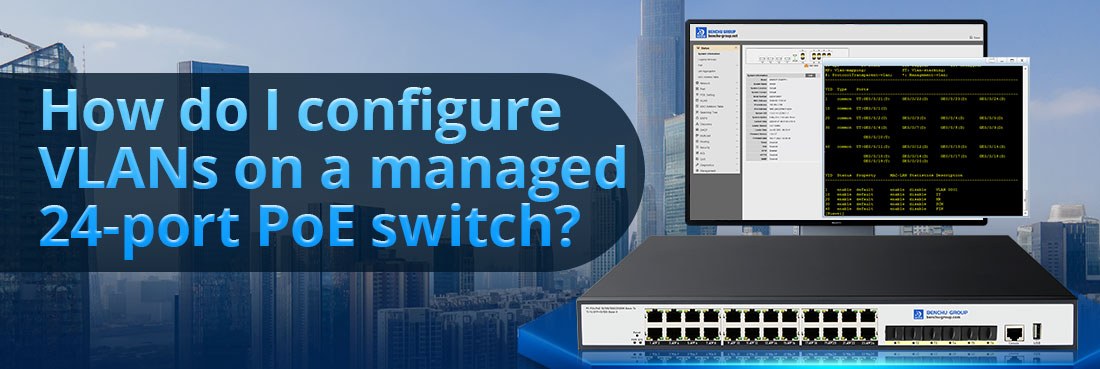
Configuración de VLAN (redes de área local virtuales) en un puerto administrado de 24 conmutador PoE le permite segmentar su red en distintos grupos para una mejor seguridad, rendimiento y administración. Aquí hay una guía paso a paso para ayudarlo a configurar las VLAN de manera efectiva:
Paso 1: comprender los conceptos básicos de VLAN
1. ¿Qué es una VLAN?
--- Una VLAN separa una red física en subredes lógicas. Los dispositivos en la misma VLAN pueden comunicarse directamente, mientras que los dispositivos en diferentes VLAN requieren un enrutador para la comunicación.
--- Las VLAN se identifican mediante ID de VLAN (1–4095), y normalmente 1 se reserva como VLAN predeterminada.
2. Tipos de VLAN comunes:
--- Acceder a VLAN: Los puertos se asignan a una única VLAN, comúnmente utilizada para dispositivos de usuario final como PC.
--- VLAN troncal: Los puertos transportan tráfico desde múltiples VLAN, generalmente utilizados para conexiones entre conmutadores o conmutadores y enrutadores.
Paso 2: acceda a la interfaz de administración del conmutador
Puede configurar VLAN a través de:
1. GUI web (la más fácil de usar):
--- Encuentre la IP de administración del conmutador (generalmente en el manual o usando un escáner de red).
--- Acceda a través de un navegador utilizando su dirección IP (por ejemplo, http://192.168.1.1).
--- Inicie sesión con credenciales de administrador.
2. Interfaz de línea de comandos (CLI) (a través de SSH o consola):
--- Utilice herramientas como PuTTY o una conexión directa a la consola.
--- Inicie sesión con credenciales de administrador.
3. Software de gestión específico del conmutador (opcional):
--- Algunos fabricantes ofrecen aplicaciones dedicadas para administrar VLAN.
Paso 3: crear VLAN
Usando la GUI web:
1. Inicie sesión en la interfaz de administración.
2. Vaya a Configuración de VLAN:
--- Navegue hasta la sección denominada "Administración de VLAN" o "Configuración de VLAN".
3. Cree VLAN:
Agregue ID y nombres de VLAN:
Ejemplo:
--- ID de VLAN: 10, Nombre: "Ventas"
--- ID de VLAN: 20, Nombre: "Marketing"
--- Guarde la configuración.
Usando CLI:
1. Acceda al modo de configuración de VLAN:
| Cambiar# configurar terminal |
2. Defina las VLAN:
Ejemplo para crear VLAN 10 y VLAN 20:
| Cambiar(configuración)#vlan10 |
| Cambiar(config-vlan)# nombre Ventas |
| Cambiar(config-vlan)# salida |
| Cambiar(configuración)#vlan 20 |
| Cambiar(config-vlan)# nombre Comercialización |
| Cambiar(config-vlan)# salida |
Paso 4: asignar puertos a las VLAN
Usando la GUI web:
1. Navegue a Configuración de puerto:
--- Busque la sección "Membresía de VLAN de puerto" o "Configuración de interfaz".
2. Establecer membresía del puerto:
--- Asigne puertos específicos a las VLAN:
--- Puertos 1–12: VLAN 10 (Ventas).
--- Puertos 13–24: VLAN 20 (Marketing).
Establecer tipos de puertos:
--- Puerto de acceso: para dispositivos finales como PC, impresoras o cámaras.
--- Puerto troncal: Para conectarse a otro conmutador o enrutador, permitiendo múltiples VLAN.
3. Guarde la configuración.
Usando CLI:
1. Asignar puertos de acceso:
Ejemplo para los puertos 1–12 a VLAN 10:
| Cambiar(configuración)# rango de interfaz gigabitEthernet 0/1-12 |
| Cambiar(configuración-if-rango)# acceso al modo switchport |
| Cambiar(configuración-if-rango)# acceso al puerto de conmutación vlan 10 |
Para los puertos 13–24 a VLAN 20:
| Cambiar(configuración)# rango de interfaz gigabitEthernet 0/13-24 |
| Cambiar(configuración-if-rango)# acceso al modo switchport |
| Cambiar(configuración-if-rango)# acceso al puerto de conmutación vlan 20 |
2. Configurar puertos troncales:
Ejemplo de puerto 24 como troncal:
| Cambiar(configuración)# interfaz gigabitEthernet 0/24 |
| Cambiar(configuración-if)# troncal en modo switchport |
| Cambiar(configuración-if)# troncal de puerto de conmutación permitido vlan 10,20 |
Paso 5: verificar la configuración de VLAN
Usando la GUI web:
--- Verifique el resumen de VLAN o las asignaciones de puertos en la sección Administración de VLAN.
--- Asegúrese de que los puertos estén asignados a las VLAN y configuraciones troncales correctas.
Usando CLI:
--- Utilice los siguientes comandos para verificar:
Resumen de VLAN:
| Cambiar# mostrar resumen de VLAN |
Estado del puerto:
| Cambiar# mostrar interfaces switchport |
Paso 6: Probar la conectividad
1. Dentro de la misma VLAN:
--- Los dispositivos en la misma VLAN (por ejemplo, VLAN 10) deben comunicarse sin problemas.
2. Entre diferentes VLAN:
--- Los dispositivos en diferentes VLAN (por ejemplo, VLAN 10 y VLAN 20) necesitarán un enrutador o conmutador de Capa 3 para la comunicación.
--- Configure el enrutamiento entre VLAN en el enrutador si es necesario.
Paso 7: guarde la configuración
Asegúrese de que su configuración persista después de reiniciar el conmutador.
Usando la GUI web:
--- Haga clic en "Guardar" o "Aplicar" en la interfaz de administración.
Usando CLI:
| Cambiar# escribir memoria |
or
| Cambiar# copiar configuración en ejecución puesta en marcha-configuración |
Paso 8: (Opcional) Habilite las funciones PoE para dispositivos VLAN
--- Si sus dispositivos VLAN (por ejemplo, cámaras IP o puntos de acceso) requieren PoE, asegúrese de que PoE esté habilitado en los puertos relevantes.
--- Verifique la configuración PoE del conmutador para asignar energía de manera eficiente.
Conclusión
Configuración de VLAN en un sistema administrado Conmutador PoE de 24 puertos Proporciona una estructura de red escalable y segura. Le permite aislar el tráfico, priorizar recursos y administrar dispositivos de manera efectiva. Siga esta guía para configurar VLAN a través de la GUI o CLI y pruebe su configuración para asegurarse de que satisfaga sus necesidades de red.